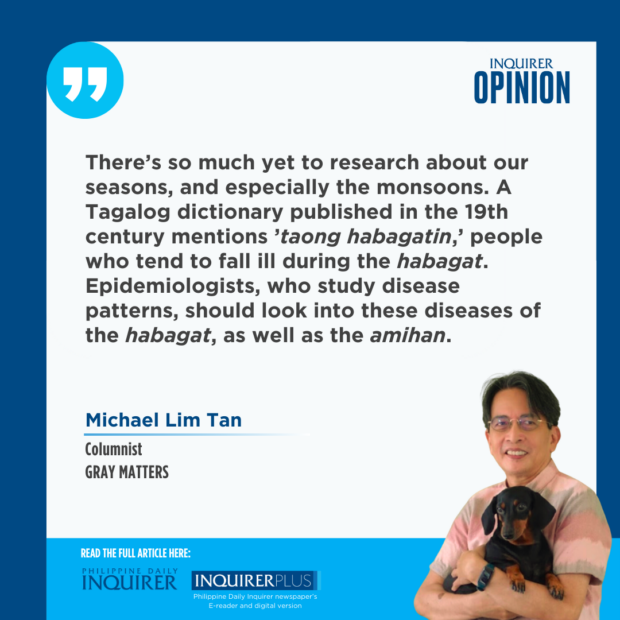
It is always good to hear from fellow senior citizen readers. Custodio, who I had not met before and is retired from government with a background in wildlife biology and ecology, wrote to question the use of “summer” for the Philippines and points out we only have two seasons: wet and dry.
I checked with Pagasa, an abbreviation of the kilometric Philippine Atmospheric, Geophysical, and Astronomical Services Administration, and they confirm the Philippines only has a dry and wet season.
What about the four seasons we hear so often? Are you hearing “winter, spring, summer, or fall?” in your head, and did you remember it was Carole King singing “You’ve Got a Friend”? All you’ve got to do is call. Okay, okay, enough already, but it is nice if you have friends covering you all-year round.
But in the Philippines, the song just does not apply. The Philippines is located too close to the equator to have wide differences in temperature and in light, which are the basis for the four seasons. Yes, we are hot all-year round and our so-called summer is a bit hotter, made worse by its being dry.
If Custodio hadn’t written in, I would not have thought about our strange use of the word “summer.” Note, too, that we never use the Spanish word, verano, so it would seem then that it was the Americans who gave us the word, probably accompanied by expletives to complain about the heat. Summer was actually less of a term referring to a season than a way to designate a kind of vacation or rest period, thus “summer vacation,” “summer break,” and Baguio as the “summer capital.”
To be more accurate, we could refer to a dry season and a monsoon season. “Monsoon” is in fact derived from the Arabic mawsim, which means “season,” specifically referring to rain and wind patterns. In the Philippines, one folklore version describes two monsoons as siblings: ”habagat,” a rough and tumble brother and ”amihan,” a gentler sister.
In meteorological terms, habagat is the southwest monsoon, with interacting high-pressure areas in the Australian continent and low-pressure areas in North China, Mongolia, Siberia, bringing heavy rains usually from June to about September.
When the amihan or northeast monsoon takes over, winds from Siberia and China descend into Southeast Asia, bringing in what used to be described as gentler winds, lasting from about October to March.
But, as we have seen in the last two decades or so, the amihan has been bringing in the most destructive typhoons for the country. I referred to them last week as the “bulaga” typhoons, surprising us as we are caught off guard thinking that by September, the typhoon season would be over.
This year, the amihan was particularly disastrous when within one month, October to November, we had six destructive typhoons. At one point, four of these typhoons appeared simultaneously in the Pacific, encircling the Philippines.
The monsoons should also be explained in relation to four climate types in the Philippines, which create more variations in terms of the monsoons. For example, Mindanao used to be spared strong typhoons because they were affected more by the amihan and as that monsoon became more powerful, we saw how Mindanao would be furiously assaulted by these “late” typhoons.
We should also look at the seasons as signs or markers. Our farmers in Luzon and the Visayas fear the habagat but also welcome its rains, a signal to start planting rice. In centuries past, the habagat and amihan brought different maritime visitors and their ships from throughout the world into and out of Southeast Asia, sailors having learned how to navigate around the monsoons.
Custodio notes, too, how an awareness of seasons based on “wet” and “dry” better explains seed drops and fruiting seasons for plants, and animal migrations (I thought of our marine mammals and birds), stretching thousands of kilometers.
Talking about fruiting, I’ve even wondered about the spike in human births in the Philippines around September. Being a Virgo myself, I joke about having been “made during Christmas” but lately, I’ve wondered if it should be more appropriately called a “made during the amihan” with its cool and mild winds and rain.
There’s so much yet to research about our seasons, and especially the monsoons. A Tagalog dictionary published in the 19th century mentions “taong habagatin,” people who tend to fall ill during the habagat. Epidemiologists, who study disease patterns, should look into these diseases of the habagat, as well as the amihan.
—————
mtan@inquirer.com.ph